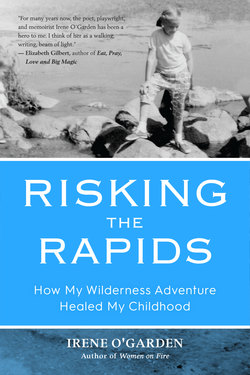Читать книгу Risking the Rapids - Irene O'Garden - Страница 10
На сайте Литреса книга снята с продажи.
ОглавлениеTangletown, Midcentury
Traveling north on 35W, we could see downtown Minneapolis spring up from the plains like a spread in a pop-up book. Our family emerged from stability itself: the wide flat plains of the upper Midwest, and the level terrain of our parents’ “’til death-did-them-part” marriage.
To a child’s eye: a shimmering blue Emerald City. The sturdy Curtis Hotel, the Foshay Tower, shaped just like the Empire State Building; later, the IDS rising up, a real skyscraper. Minneapolis. An oasis of lakes and forward thinking. Why, in 1958, the first indoor shopping mall was invented and built here. In 1963, one of the first regional repertory theatres was started by Tyrone Guthrie. Five years later, downtown’s main street, Nicollet, would be planted with trees and closed to automobiles—a radical, internationally-noted and imitated innovation: the Pedestrian Mall. An I.M. Pei building would anchor it. In a few more years, Mary Tyler Moore would toss her hat here. How right she was.
Downtown. The magical place you went when Mom was in a good mood. Step on the wooden shoe-sizer, get your stocking-foot measured, Buster Browns or bump-toed blue Keds to try on, march up and down the little you-sized staircase, hear the jangly snick-snack of Mom’s charge-a-plate, then eat plush coconut marshmallows on the cab ride home.
(Unless she bought you the horrible brown Oxfords, which looked like corrective shoes and all the kids would laugh, but why did she do it and make you wear them? Your feet were okay.)
They called them “The Twin Cities,” but they never seemed Twin to us—Minneapolis all silver, blue, shiny; St. Paul all dark brown, old wood, like our old confessionals before they built the new church.
Our neighborhood was known as Tangletown. Unlike the orderly elm-lined avenues of the rest of Minneapolis, these streets meandered any which way. Minnehaha Creek, not a grid-minded city planner, had laid the houses out herself, around curves and slopes—precious terrain in Flatland. Pretty, but people had a hard time finding us.
Ours was a smallish lot right on a curve. The front yard was Dad’s hope for a lawn, scruffy until he banished play to the back yard. A few towering black-barked oaks and a “please don’t strip that” beloved paper birch tree with its fascinating white curls blessed the front yard, as well as a trio of hemlocks outside my bedroom window which scattered the streetlight across my walls at night. A couple scrubby peonies and a foundation planting of juniper struggled in front of the sunroom, and oddly placed near the public sidewalk grew a clump of barberry. Within its hollow, I founded the short-lived Prickerbush Club, consisting of me and my neighbor girl, Cindy Massenger. We held meetings when John had meetings of the club he wouldn’t let us join. Since exclusivity was our raison d’être and the prickers hurt, we swiftly disbanded.
On the north, we were close enough to read the fine print on a neighbor’s cereal box. To the south was a wider shrubby side yard which protected Mr. Massenger’s dahlias from our scuffling Keds. Best of all, right across the street from our front door was an almost private wilderness: the green effusion along Minnehaha Creek. The outdoors we could never wait to get to, the outdoors that took us to school and to Mass, took me away from the clamor and chaos of six other scrambling siblings.
The funny old barn-shape of our house always embarrassed me. It was a 1924 Dutch Colonial—a perfectly acceptable architectural style—but it sure didn’t resemble the pointy-roof houses around us or in picture books. Just one of the ways our family wasn’t like others. Ours was the only mother who didn’t drive. She said she was nervous “propelling two tons of steel down an avenue,” failed her test three times, and from then on was chauffeured—by Dad, bridge club friends, the trusty yellow cab company, eventually the Olders, and subsequently the Youngers.
(The continental divide between the Olders and the Youngers was The Little One We Lost. Born prematurely, Joseph died at nine hours old, nearly taking Mom with him. Mom told us later she was mad the doctors brought her back. “It was so beautiful. I was leaping from mountaintop to mountaintop.” Her glimpse of afterlife has stayed with us all. Against her doctor’s advice, she later gave birth to John, me, Jim and Ro.)
Clad in white clapboards and dark green shutters, the house sported green and taxi-gold striped awnings in the summer, eye-pleasing till they grew tattered. One day they were gone and never replaced.
If it’s fall, Pogo and Tom are horsing around with sloppy soap and squeegees to the rise and fall of the play-by-play of the Golden Gopher college football game. While they wash and put up the tricky storm windows, we Youngers are raking, jumping in and burning the leaves, the blue-smoke smell dear and elusive, like memory itself.
No need to use the brass knocker with the little peep-door in it (The Wizard Is In!) Come in, hang your coat in the little closet. Or throw it on the couch with ours. Mom’s at a luncheon anyway.
There’s Copper Jesus, hanging on His Cross hanging on the wall. So sad. Then Palm Sunday fronds crisp like cornflakes behind Father Dudley’s house blessing. We’re lucky to have priests to help us renounce Satan, who tries to get us if he can. On the table below, monkey-pod pineapple holding rosaries, bobby pins, Monopoly top hat, and never-used keys to our never-locked doors.
This is my staircase I flew up and down. Really flew. It’s my first memory. Then again and again, which I wish I could teach you. But no one believed me. So I forgot how. Even watching Peter Pan, I never can fly to Neverland.
